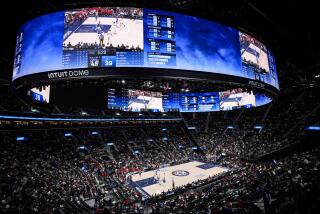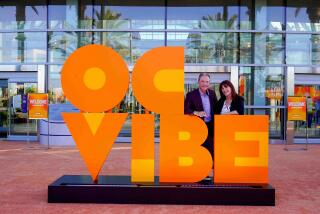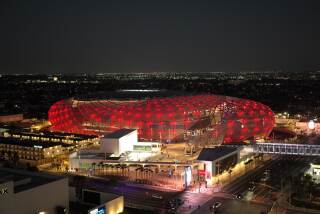For Taxpayers, the Devil Is in the Arena Details
- Share via
While I still haven’t seen the secret Los Angeles sports arena contracts, I’ve learned more about the deal, thanks to real estate experts, lawyers and contacts in the gossipy world of sports business.
As you might recall, I’ve been trying for weeks to get hold of the secret contracts that supposedly guarantee that the Kings and Lakers will play in the $240-million facility for 25 years. If the teams leave before that time, the arena would be an elegant but empty shell, without enough ticket sales to pay off the $70 million the city taxpayers are providing toward the $240-million cost.
Last week, I sent another letter to City Atty. Jim Hahn asking that the contracts be opened up, as required by the California Public Records Act. But who knows what will become of my request.
Meanwhile, luckily for me, a deal as big as this one is too big to keep completely secret.
*
*
Checking around, I discovered some of the details of one of the ways the arena developers will profit from the deal by the selling of the arena name.
The uninitiated may think this arena, substantially financed by us taxpayers, will be named after our city and that the camera in the Goodyear blimp will focus on the “L.A. Arena” sign.
Or possibly the arena might carry the name of one or both of the teams, in the manner of Dodger Stadium. Or it might have a name ringing with tradition, emulating the Memorial Coliseum, Soldier Field and Madison Square Garden.
Unfortunately, that’s not how arenas are named in today’s money mad world of big time sports, where everything is for sale, even the players’ autographs.
Big companies pay big bucks to have arenas and stadiums bear their corporate logos and names. In Phoenix, the new baseball team will play in Banc One Ballpark, and the basketball team performs in an arena named after America West Airlines. The San Francisco Giants play baseball in 3Com Park.
Our arena builders may do these teams one better.
An insider who has talked to the arena architects said “‘the sponsor’s identity will be integrated into the design.”
Think of that. I saw a model of the arena and it looked pretty conventional. Maybe the final version will be shaped like a giant computer, a utility vehicle, a 747 or a bagel.
Our arena developers have already begun selling the arena name to the corporate world. When they made their first pitch, they asked for $115 million for the naming rights, according to Alan Friedman, executive editor of Team Marketing Reports, which reports on the sports business.
But the word is the price is going up, for the arena is prime advertising space. It’s at the intersection of two of the world’s most traveled freeways, the Harbor and the Santa Monica. And beyond that, the arena image will be carried worldwide, for sports contests and other events that would be staged there.
One source, deeply involved in the sports business, told me the asking price was now in the neighborhood of $150 million.
And apparently, the city won’t get a penny of it. At least there’s no mention of a city share in the few documents that have been made available. My sources say that many local governments share the naming fees with the arena companies.
These are the kinds of details we should know about before the City Council votes on the arena in September or October.
But we won’t. True, the City Council has asked for the contracts containing the information, as has City Atty. Hahn. But they are confronted with a confidentiality agreement signed last June by Hahn’s lawyers and the arena attorneys specifically banning release of information about sponsorship, as these name sellings are called.
*
*
I bet the arena developers, Ed Roski and Phil Anschutz, wouldn’t invest without knowing such facts. That’s not how Anschutz became one of America’s richest men, with assets estimated by Forbes magazine this year at $5 billion.
But that’s what we taxpayers and our elected representatives are doing.
We are giving these two men $70 million, which we are borrowing through the sale of bonds and from a city reserve fund. The cost of borrowing this money is $6.8 million a year, or $170 million over the 25-year life of the deal.
We hope to repay this debt with revenues from parking, business licenses, utility taxes and other levies on revenues from the project.
It will be a struggle to work ourselves out of that huge debt. It will be impossible if the Lakers and Kings leave town prematurely.
That’s why these details, such as the sale of the arena name, should be out on the bargaining table, in public, rather than being hidden by the men who will profit so greatly from them.
More to Read
Go beyond the scoreboard
Get the latest on L.A.'s teams in the daily Sports Report newsletter.
You may occasionally receive promotional content from the Los Angeles Times.










